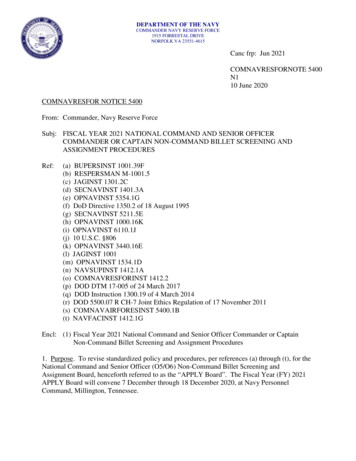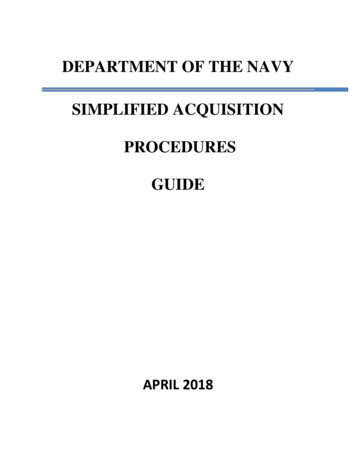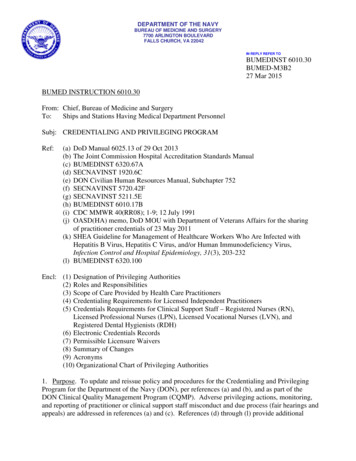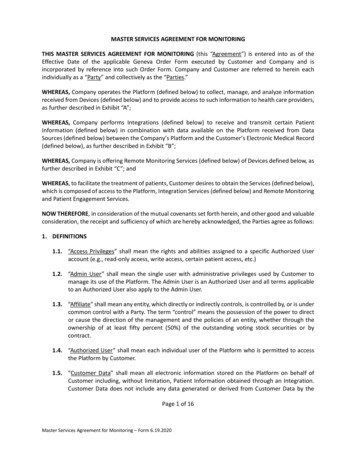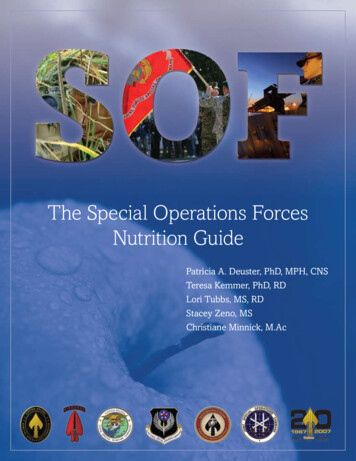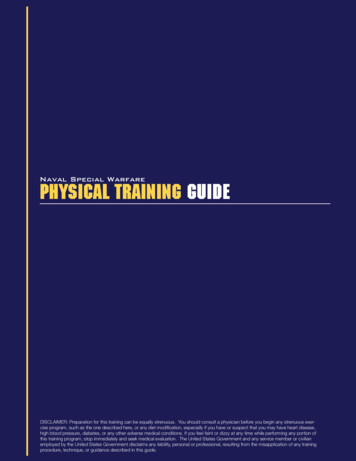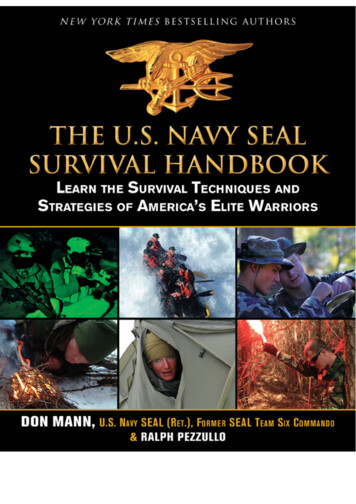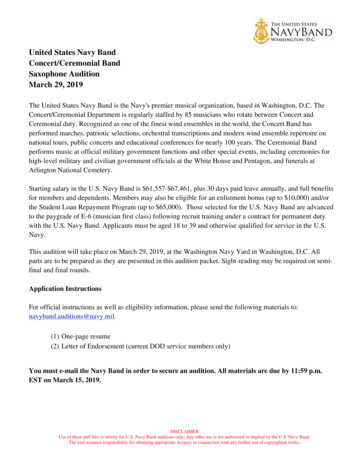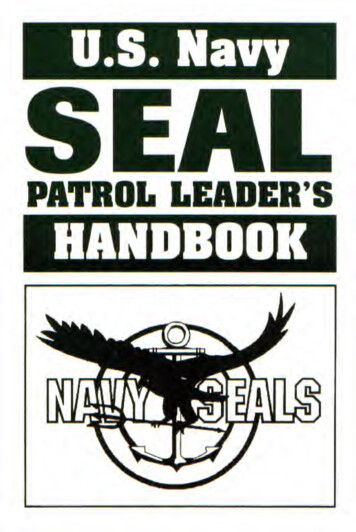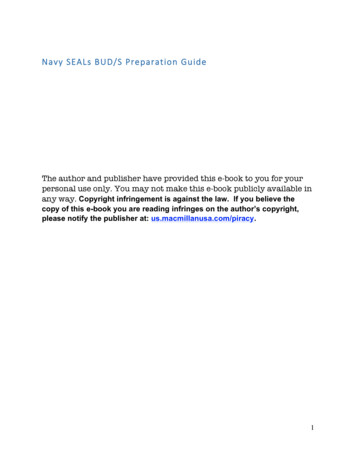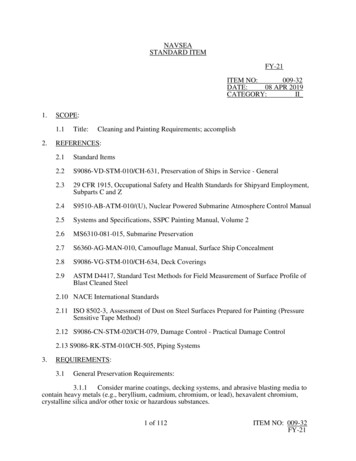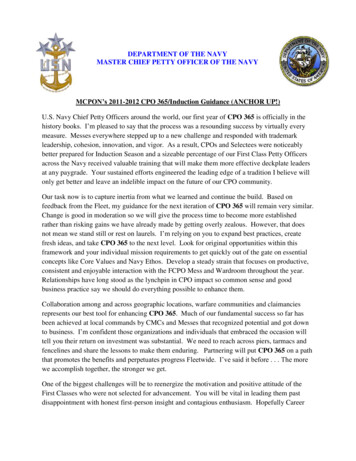
Transcription
DEPARTMENT OF THE NAVYMASTER CHIEF PETTY OFFICER OF THE NAVYMCPON’s 2011-2012 CPO 365/Induction Guidance (ANCHOR UP!)U.S. Navy Chief Petty Officers around the world, our first year of CPO 365 is officially in thehistory books. I’m pleased to say that the process was a resounding success by virtually everymeasure. Messes everywhere stepped up to a new challenge and responded with trademarkleadership, cohesion, innovation, and vigor. As a result, CPOs and Selectees were noticeablybetter prepared for Induction Season and a sizeable percentage of our First Class Petty Officersacross the Navy received valuable training that will make them more effective deckplate leadersat any paygrade. Your sustained efforts engineered the leading edge of a tradition I believe willonly get better and leave an indelible impact on the future of our CPO community.Our task now is to capture inertia from what we learned and continue the build. Based onfeedback from the Fleet, my guidance for the next iteration of CPO 365 will remain very similar.Change is good in moderation so we will give the process time to become more establishedrather than risking gains we have already made by getting overly zealous. However, that doesnot mean we stand still or rest on laurels. I’m relying on you to expand best practices, createfresh ideas, and take CPO 365 to the next level. Look for original opportunities within thisframework and your individual mission requirements to get quickly out of the gate on essentialconcepts like Core Values and Navy Ethos. Develop a steady strain that focuses on productive,consistent and enjoyable interaction with the FCPO Mess and Wardroom throughout the year.Relationships have long stood as the lynchpin in CPO impact so common sense and goodbusiness practice say we should do everything possible to enhance them.Collaboration among and across geographic locations, warfare communities and claimanciesrepresents our best tool for enhancing CPO 365. Much of our fundamental success so far hasbeen achieved at local commands by CMCs and Messes that recognized potential and got downto business. I’m confident those organizations and individuals that embraced the occasion willtell you their return on investment was substantial. We need to reach across piers, tarmacs andfencelines and share the lessons to make them enduring. Partnering will put CPO 365 on a paththat promotes the benefits and perpetuates progress Fleetwide. I’ve said it before . . . The morewe accomplish together, the stronger we get.One of the biggest challenges will be to reenergize the motivation and positive attitude of theFirst Classes who were not selected for advancement. You will be vital in leading them pastdisappointment with honest first-person insight and contagious enthusiasm. Hopefully Career
Development Boards were conducted and much of the groundwork for bringing those Sailorsseamlessly back into the mix has been laid. I encourage you to utilize them in leadership roleswhenever possible. They will understand your expectations, proactively participate from aposition of experience, and appreciate the faith.Phase 3 of CPO 365, Induction Season, will always rightfully remain at the heart of our heritageand the ultimate gateway for all those who desire to earn the title “CHIEF”. I’m certain,though, we’ve shown through results that there is room and responsibility for Messes to engageup and down the chain of command as a regular practice rather than a six-week scramble.Phases 1 and 2 are not intended to diminish the impact of Induction but to solidify confidenceand camaraderie that intensify Induction. They are distinct and separate segments with verydiverse objectives and tempo. All CPOs and FCPOs who participate should be familiar with thegoals, and have a clear sense of increased pace and complexity as they move from one phase toanother.Regardless of the phase, safety and situational awareness must be paramount in all our trainingevents. Recognize and mitigate risk in advance as you do with all other evolutions, and do notjeopardize this incredible, time-honored tradition with outdated antics that can unnecessarily leadto injury. Intervene on the spot if necessary to stop someone from getting hurt or if you seeShipmates stepping outside acceptable conduct. Clearly communicate and enforce the rules ofengagement.CPO 365 is serious business designed to build new Chief Petty Officers through controlled,constructive mental and physical stress. It should not be dismissed as ―reindeer games‖, a―kangaroo court‖, or any other silly nickname that undermines the true intent - nor should everytraining event be a pre-meditated confrontation staged mainly to frustrate or provoke Selectees.Positive reinforcement and two-way dialogue can pay big dividends, especially early in theprocess at functions like the Meet-and-Greet. This does not mean there isn’t an occasional placefor conflict – only that those methods are far more effective when used in concert with otherapproaches. You will notice that I’ve reintroduced the ―Do and Do Not‖ section of the guidancebecause I want to eliminate any room for interpretation on a few specific subjects that can runcounter to our goals.CMCs remain ultimately responsible for the safe conduct and successful execution of all threephases of training. They will be actively involved from beginning to end. Aside from thoroughprocess preparation, CMCs will brief Commanders/Commanding Officers on their local CPO365 process and provide regular updates to keep them informed of progress. Additionally,CMCs will ensure all members of their Messes are participating regularly throughout the yearrather than just showing up at a few events during Induction Season. CMC leadership reinforcesthe idea that CPO 365 is instrumental to the ongoing professional development of Sailors andrelevant to command esprit de corps.
I’m proud of the strides we’ve made in rolling out CPO 365 as a sustained, visible commitmentto our Shipmates on the deckplates and in the Wardroom. You made it work and you will makeit better. I value your input to this evolving process and look forward to seeing your MessesAnchor Up throughout the year. HOOYAH!R.D. WestMaster Chief Petty Officer of the Navy
General Guidance for CPO 365This document does not dictate to you how to induct our new Chief Petty Officers. It does notspecify every right or every wrong. I’m giving CMCs the flexibility to run Induction the wayyou see fit, but do not mistake my intent. Every event should be planned in alignment with theNavy Ethos, Core Values and the CPO Mission, Vision and Guiding Principles. With this inmind, it is up to you to train and develop the Sailors under your charge and when they provethemselves to you accept them into our Mess. I trust every one of you to ensure that whenthese leaders are accepted into our Mess, they’ve earned that honor.The three phases of CPO 365 are designed to ensure that we are continually and steadilypreparing our PCPOs to enter the Mess on September 14. As leaders, if you are only relying ona 5- to 6-week time period to prepare our First Class Petty Officers for Chief, then you havemissed the mark and have fallen short in delivering our Mess a Chief that is full-up and ready towear Anchors.Ensure Reserve Component PCPOs are incorporated into the command’s CPO 365 process.Reserve Component Selected Reserve (SELRES) Selectees who travel very long distances areauthorized to complete Phase Three, the Induction process, at their local (closest) Navy ReserveActivity (NRA). Our SELRES Sailors should not be penalized because of the reduced time theyhave to apply to the process resulting from their civilian employment. Commands need toembrace these differences, bring them on board as part of the team, and continue their CPO 365training like any other PCPO.The following phases of development and training (CPO 365) are examples of what shouldoccur as we engage our First Class Petty Officers and prepare them to enter the ChiefsMess.Phase 1: Begins September 17 and is used to build the foundation in the year-round trainingcycle. This phase sparks the teamwork and initial training to engage the FCPOs on their road tobecoming Chief Petty Officers. CMC trains FCPO Mess on Expectations of the PCPO. Perform fitness and nutritional assessments of all FCPOs to develop personal trainingplan that will foster sound physical readiness. Utilize a Personal Training Plan to provideconstructive guidance and expectations to FCPOs. The Navy Fitness Training Plan website includes numerous other resources that can be considered. Visit the Navy Operational Fitness and Fueling Series (NOFFS) web site to identifyworkouts tailored to your platform, location and individual Selectees – a great way to getSailors at different fitness levels involved in a group workout. Participate in community service events with CPO/FCPO Messes. This includes, but isnot limited to, CPO runs in conjunction with local road races/fun runs and contributionsto other community relations efforts such as facilities/landmark restoration projects. Conduct periodic CPO/FCPO/Wardroom combined training/teambuilding and PT events. Visit/Conduct training at Fleet Family Support Center (FFSC) and Navy and MarineCorps Relief Society office. Conduct periodic FCPO Mess Training:1 of 11
o (possible subjects: Sponsor and Indoctrination, CDBs, Mentorship, Recognition,Perform to Serve, Navy Equal Opportunity, DAPA/UPC, SAPR, FAP, ORM, andHeritage)Phase 2: Begins when the board eligible results are released and will build upon what wasstarted in Phase 1. This phase is dedicated to further preparing ―board eligible‖ personnel tocross into and be a productive member of the CPO Mess. Conduct a Career Development Boards (CDB) on non-board eligible FCPOs,concentrating on what they need to work on for their continued development. Conduct a mock BCA and PFA on all board-eligible FCPOs. Refine personal trainingplans at NOFFS for FCPOs to maximize fitness levels prior to Phase 3. Conduct periodic CPO/FCPO/Wardroom combined training/teambuilding and PT events. Participate in community service events with CPO/FCPO Messes and Wardroom. Conduct periodic FCPO Mess Trainingo (possible subjects: Junior Officer interaction, Division Officer notebook, Manning(EDVR and AMD), EFM, CACO, and Heritage)Phase 3 (Induction): Begins when the PCPO becomes a Selectee, and is designed as the finaltraining period to better prepare a Selectee for his/her entry into the Chiefs Mess. Induction isimportant to us as a Mess and also to the Navy. It rejuvenates our Chiefs while we preparethousands of Sailors to join our ranks. More importantly, it prepares those leaders to uphold thecredibility of our community and lead Sailors on the deckplate. I have every intention ofpreserving this tradition and ensuring it remains relevant, and so should each person that hasthe honor of wearing the Anchors of a Chief Petty Officer. Induction will culminate in thecapstone event on September 13, followed by a pinning ceremony on Friday, September 14,2012. Conduct CDBs on non-selected PCPOs. Conduct Selectee Spouse Symposium Conduct Meet-and-Greet with Selectees and families (a critical step). Assign Charge Book. Complete CPOSLC. Execute required command training for CPO Mess. Conduct CPO/Selectee/Wardroom combined training/teambuilding and PT events. Perform fund-raising necessary to cover Induction expenses only. Complete heritage training. Perform Battle Stations or other capstone event. Perform Pinning Ceremony.At the end of Phase 3, when our Selectees have earned their Anchors, I expect they will lookback at CPO 365 as one of the most challenging, yet rewarding experiences of their career. It’sup to you to ensure this happens professionally. Use common sense and trust your instincts. Allof us know the climate in which we live and work, and the right way to do business. Actaccordingly, but keep this in mind: nothing worth having comes easy. This is not a ―dinner anda handshake.‖ We are in the business of building, developing and challenging our SeniorEnlisted Leadership. Take it seriously.2 of 11
Induction SeasonNotification.This is an important aspect of Induction and sets the expectations of the Selectees, Chief’s Mess,Wardrooms, crew and spouses. CMCs should coordinate with the Commanding Officer or OIC prior to release ofSelection Board results to determine the best method to inform those selected or notselected. Due to the many means to communicate this information, the location and theway our Sailors are operating, it’s often times impractical or impossible to hold selectionresults in abeyance until leadership has been informed. My expectation is for commandsto manage the best method for notification of their Sailors that suits the environment withwhich you are operating. Ensure each non-select is appropriately notified and given a CDB as soon asoperationally feasible. This single event could be the most important part of our CPO 365process, when developing future Chiefs. Non-Selects are a valued member of thecommand and the Navy and by conducting this CDB it allows our Mess to place them ona course for selection in the future. I recognize the challenge here, but trust our Mess tocontinue to engage with our FCPOs throughout this period and rise to the occasion as wealways do. Each CPO Selectee should be given a CDB to provide a ―road ahead‖ as they prepare forInduction and further assignment as a CPO. Selected Reservists on any type of duty (other than Active Duty Operational Support(ADOS), and Mobilization are authorized to begin their induction process uponnotification of their selection. Full Time Support (FTS) personnel may begin PT andprofessional training evolutions upon notification of their selection. FTS may not begincharge books, or PQS until the active component results are released. Selected Reservist participating in authorized training events MUST be in a drill status.In order to allow for maximum participation, SELRES personnel (CPOs and PCPOs)may utilize ―non-paid additional drills.‖ Incremental IDT periods may be utilized forSELRES that are unable to meet the full IDT Period. At no time will any SELRESpersonnel participate in any CPO 365/Induction event without being on some type oforders.Selectee Meet-and-GreetThis is an occasion for Selectees to introduce themselves to the Mess. Last year, I attended agreat example of one that involved families and included a barbecue. It set the tone for apositive experience and immediately communicated to family members, the intent and history ofInduction. The event was drastically different from other shock-and-awe sessions routinelyreferred to as meet-and-greets, but more closely resembled what I see as the true purpose. Thereis plenty of time during Induction to conduct training for Selectees – the Meet-and-Greet shouldfocus on discussing the process and welcoming families as soon as possible.3 of 11
History and Heritage.Take every opportunity to emphasize history, heritage and Naval traditions. Our strength islinked to our past. Consider utilizing the Naval History and Heritage Command website at:http://www.history.navy.mil Learn your command and Navy history. It is important for our new CPOs to beconnected with and fully understand our past as we continue to forge the future. An example of heritage is that many Messes now maintain their guidon from year-toyear; this is a great illustration of history and heritage in the making. Just imagine, aCMC going back to the command they made CPO at 10 years before and showing thoseSelectees their name on the streamer. Each Induction, their Selectees add a battlestreamer with all their names on it. What a great way to recognize the Chiefs who havegone before them. Ideas like that are what keep our Mess strong and Induction seasonrelevant. Many areas our forces are located have rich Naval history and many maritime venues toutilize during the course of the year use them. This drives home where we’ve beenand continues to build upon the foundation from those who have gone before us. Have Selectees learn a part of our history and present it to the Mess. That education canbe derived from books recommended by the CMC, or personal conversations with ourveterans and retired CPOs.Navy Retirees.Our retiree community is a national presence. Find the retired Chiefs, brief them on thisdocument and the guidelines to be adhered to in the conduct of Induction, encourage them toparticipate, and to share their experiences with our Mess. Remind these men and womenretirement does not mean they have been forgotten; they are a precious resource we mustcontinue to cultivate and involve in Induction and Mess activities all year round. Be creative.Fundraising.Monies raised by Selectees will be limited to the direct costs of their professional development.It will also be used for team building and unit cohesion. Fundraising time should certainly notsupersede training time, nor will it be used as a means to raise funds for the Mess. Funds raisedduring Induction period will be strictly used for the Selectees only. Working closely with thetreasurer, the CMC must be able to account for all fundraising and expenditures. Consider Navycharities or organizations as a means to dispose of any extra funds raised during this period.Other service/nation participation.Other service/nation E-7s through E-9s may fully participate in Induction only with therecommendation of your FORCE/ISIC CMC and final approval from the FLTCM. Fullparticipation throughout Phase 3 from the day of notification through the pinning ceremony isrequired.4 of 11
Physical Fitness Training.Physical Fitness is a continual process, whether group or individually based, and buildscamaraderie quicker than almost any other activity. It is one area that benefitted considerablyfrom the introduction of CPO 365 as many CPOs and Selectees started Induction in much bettercondition. I think we can improve even further by capitalizing on the many Navyprograms/resources available to assist in developing and maintaining physical fitness habits.The Navy Operational Fueling and Fitness Series (NOFFS) may be downloaded from CNIC’sFitness, Sports and Deployed Forces web site at www.Navyfitness.org. Prior to participating in any Physical Training, any/all personnel must meetrequirements set forth in OPNAVINST 6110.1J (screened and medically cleared) Conduct one-on-one fitness assessments of individual Selectees and develop personaltraining plans using form at http://www.navy-prt.com/files/Personal Training Plan.pdf. An official PFA should be conducted IAW OPNAV 6110.1J at the completion of theInduction season to provide the Commanding Officer with necessary frockinginformation while ensuring all CPOs meet current standards. Commands will performthe PFA in the Navy Physical Training Uniform (PTU). PT should be group-oriented, build camaraderie and reflect a strong sense of esprit-decorps among the Selectees and the Chiefs. PCPOs should be within PFA standardsprior to starting Phase 3. PT should follow a building-block process that gradually increases aerobic capacity andmuscular strength. Start out with short runs and simple calisthenics. Emphasize properform early and avoid events that could injure personnel unaccustomed to high-intensityexercise. Remember to hydrate frequently and to have medical personnel present at allphysical training evolutions. Selected Reservists shall not participate in any structured PT events unless they areunder/on some type of orders as specified previously.Training Guidelines.Conduct training and activities in a group format. Training must not interfere with operations orbe at the expense of mission accomplishment. Selectees should not disappear in secrecy for sixweeks and mysteriously emerge as CPOs – transparency of the process and its purpose isparamount to continued command support.
The following phases of development and training (CPO 365) are examples of what should occur as we engage our First Class Petty Officers and prepare them to enter the Chiefs Mess. Phase 1: Begins September 17 and is used to build the foundation in the year-round trainingFile Size: 346KB
